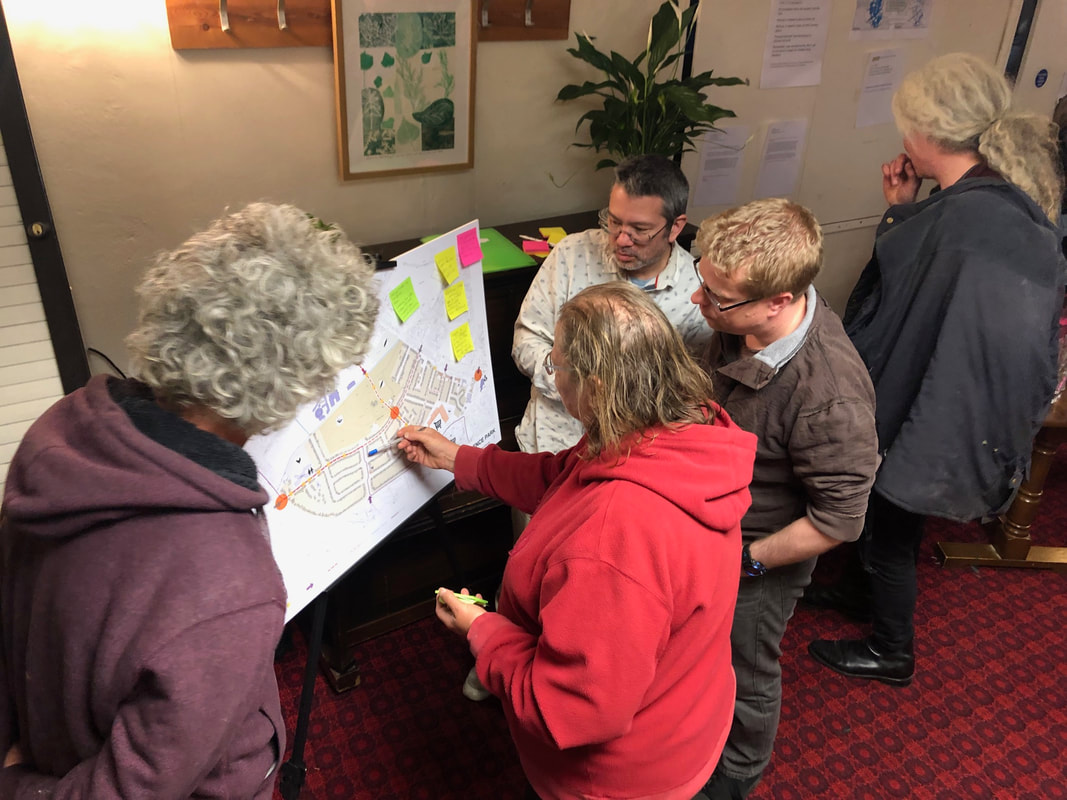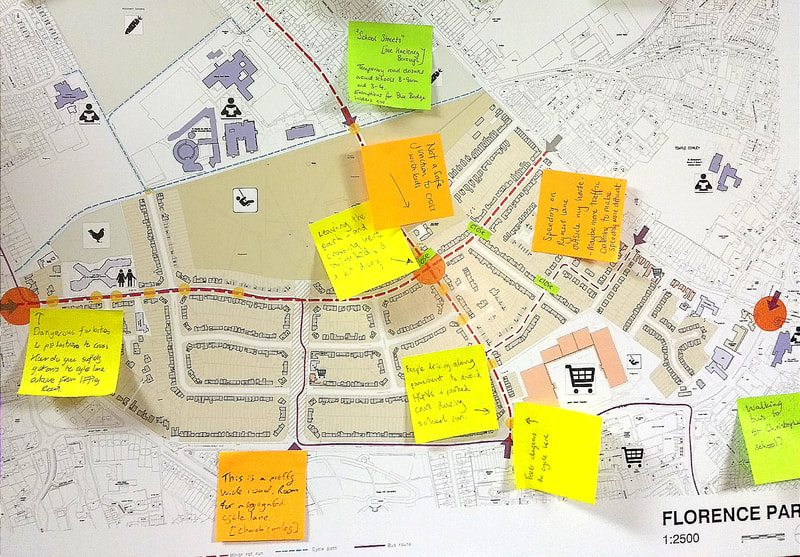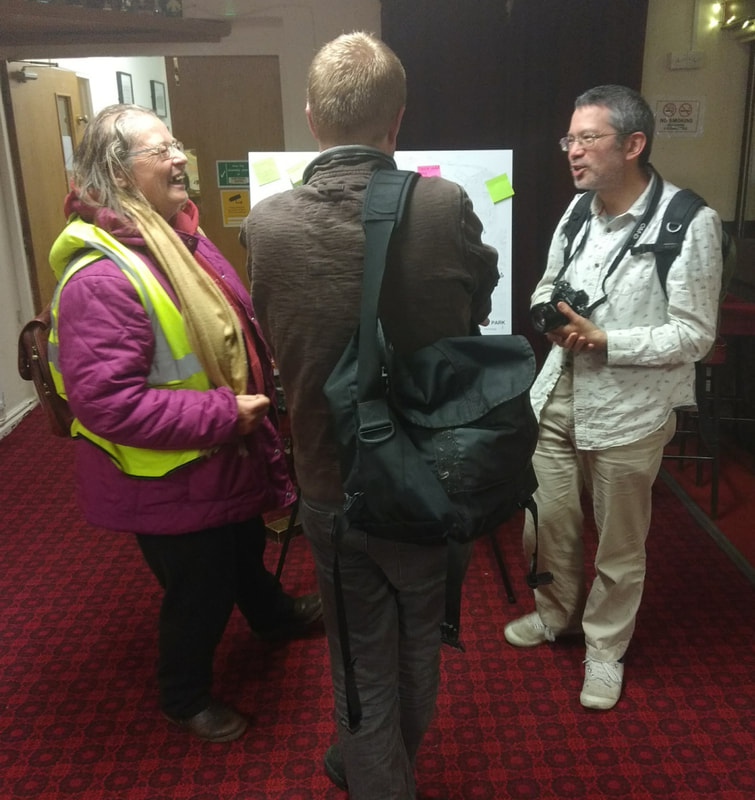|
Around 50 people turned out to a recent meeting called by a group of Florence Park residents. The "Meeting about Traffic in the Florence Park Area" was arranged after a number of discussions on the Nextdoor social media platform highlighted the danger posed by the junction of Rymers Lane and Littlehay/Cornwallis roads. The discussions on Nextdoor started with a general word of caution, but picked up considerably after a cyclist was sent to hospital following a collision at this junction the very day after the original Nextdoor post appeared. The meeting, on Tuesday, May 7, gave residents the opportunity to voice their general concerns and views about traffic, as well as to hear some proposals. John Sanders, county councillor for the area, presented his plan to build a 'raised table' at the junction. Raised tables can be found on Magdalen Road and Howard Street, not far from the estate. In the Q&A following the presentations, there was a basic tension aired between the need to act urgently -- before someone is hurt again -- and the need to take steps that are optimal. A variety of concerns were raised about the use of a raised table, while also acknowledging that from Councillor Sanders' point of view it was the method recommended to him by highways officers and was also within his power to deliver, in terms of budget, and was a way to 'do something'. The concerns were about the raised tables on Magdalen Road and Howard Street, which were said to be generally impossible to navigate with a pushchair or in a wheelchair, and make no concession to general pedestrian usage. There was also a view expressed that they don't slow traffic appreciably (though this was disputed) and that they probably contribute to kerbside pollution as drivers tend to brake hard upon approach to the table, then accelerate hard after them. We heard a short presentation about Waltham Forest, where the council has decided to stop rat-running through residential areas. A few people from Florence Park had gone to Waltham Forest in early April to see these changes, on a walking tour led by local residents. The Waltham Forest treatment -- called 'Low-traffic neighbourhoods' -- takes a fundamental approach to rat-running and the associated maladies: street danger, pollution and diminution of social ties. We heard two more presentations from people who had visited Waltham Forest. One of these focused on how the Low-traffic neighbourhood concept would help liberate this person from her car. A self-described 'petrol head', she said that having the right physical environment would greatly aid people like her in choosing to walk or cycle over 'jumping in the car'. She noted that having a Low-traffic neighbourhood would bring people together and boost the estate's sense of community and its social bonding. It would also relieve social isolation among many of our residents. She also said that Florence Park had a track record when it comes to big initiatives. The very community centre hall where the meeting was being held was cited as an example of the community coming together to reclaim an asset that was threatened with closure due to years of neglect. Flo's in the park was also cited as an example of this can-do spirit and record of achievement. She also cited earlier work by residents that resulted in removing bus-depot traffic from the estate and, later, getting a zebra crossing on Cowley Road near Clive Road. Another person who had visited Waltham Forest gave a presentation on how any changes to the neighbourhood traffic layout would have to be 'inclusive' -- in terms of delivering meaningful change that enables people of all abilities to use the streets -- as pedestrians, cyclists, scooters, wheelchair-users or drivers. The audience was told that, having tried and failed to solve rat running with a number of 'street calming' techniques -- from sleeping policemen to flower pots to pinch points (and raised tables?) -- the Waltham Forest council designated several residential areas as 'Low-traffic neighbourhoods' (LTNs) of approximately ½ to 1 square-kilometre each. They then installed a number of street closures (often by creating 'parklets' or other amenities like benches) which prevent the neighbourhood being used as a through route to outside traffic. All residents in the neighbourhood can still access their home and can still use and own cars just as before. The only difference is that in some case they might have to approach their house from a different direction (depending upon where the traffic barrier is placed). The results of this intervention in Waltham Forest have been very encouraging, in terms of dramatically lower pollution levels, much higher rates of walking and cycling and social usage of the street and neighbourhood revitalisation. The Flo Park residents who went on the Waltham Forest tour all said they were "blown away" by the look and feel of the residential streets. We also learned that more than 100 delegations from across the UK have visited Waltham Forest to learn about these changes. A member of the Co-CAFE team at Brookes University, Ben Spencer, gave a short presentation to introduce Co-CAFE and its origins in Cycle Boom. He explained how his team is offering its support for any "8 to 80" type of project in Florence Park. 8 80 refers to neighbourhoods and urban areas that are designed to be welcoming and safe for people to use on foot or cycle (or wheelchair or scooter), by people spanning roughly age 8 to roughly age 80. LTN would be such a project. This also fits with well with the principles of the World Health Organisation’s broader “Age Friendly” initiatives. Meeting attendees were invited to read more information about the LTN concept, both in terms of the 'pros' and 'cons'. Concerns about LTN implementation can be anticipated from the experience of Waltham Forest. Some of these relate to accessibility -- to residents via cars, to people with disabilities, to the emergency services, to delivery drivers, and others. Other concerns relate to 'displacement' and whether a Florence Park LTN would be a nimby-ish effort that benefited the estate at the expense of the surrounding area or people living along other cross-town routes. I will address both of these (and other concerns) in a subsequent blog post. Another concern related to the school-run traffic reaching St Gregs, St Christophers and Larkrise primary schools, and Spires secondary school, and how this would fare under an LTN scheme. To that end, we heard a presentation about 'walking buses' which are being organised across the UK to help people drop their children with parent volunteers at walkable distances from the school, to prevent the need to drop children at the school directly, and alleviate the nearby-neighbourhood traffic congestion associated with it. Also placed in the room were four easels, each with a large map of the Florence Park estate and surrounding areas. People were invited to place post-it notes on the maps to indicate concerns and ideas. Among the issues posted were the lack of pedestrian crossings along Cornwallis Road, the usage of Cornwallis and Campbell roads as a link to the Larkrise primary school, the pedestrian-unfriendly junction of Cornwallis and Iffley Road and poor behaviour at the mini-traffic-circle at Florence Park Road and Cornwallis Road. The issue of 'behaviour' triggered a lively discussion about responsibility for unsociable driving. One person urged the audience to stop describing 'cars' as the problem and instead focus on the people driving them. Another person said that in his two decades’ experience of speaking to schools about these issues, no amount of cajoling or pleading with drivers would bring lasting change. Yet another person said that "you get the driving behaviour you build for" -- in other words, if you build wide streets, you get fast speeds; if you leave through-routes, you get rat-running. Two people, both living on Cricket Road, commented on the school-run traffic problem and said this would need to be addressed in any LTN scheme. One of these people is a Scout leader, with children at St Gregs, and said there was a real appetite among parents and the school to do something about the school-run traffic mess.
City councillor David Henwood was also present and invited attendees to sign up to his Speed-watch programme, in collaboration with the police, which allows residents to speed-gun the traffic and help the police issue warnings to drivers.
0 Comments
|
AuthorsCo-CAFE is led by Tim Jones (Reader in Urban Mobility) with Ben Spencer (Research Fellow) and Tom Shopland (Co-CAFE project administrator) based in the School of the Built Environment at Oxford Brookes University. Archives
February 2020
Categories |
|
Oxford Brookes University
School of the Built Environment +44 1865 48 4061 |
|
Funded by the Lifelong Health and Wellbeing cross-Council programme. Grant No. EP/KO37242/1
|




 RSS Feed
RSS Feed


